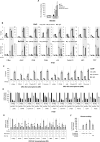Pharmacological targeting of the novel β-catenin chromatin-associated kinase p38α in colorectal cancer stem cell tumorspheres and organoids
- PMID: 33767160
- PMCID: PMC7994846
- DOI: 10.1038/s41419-021-03572-4
Pharmacological targeting of the novel β-catenin chromatin-associated kinase p38α in colorectal cancer stem cell tumorspheres and organoids
Abstract
The prognosis of locally advanced colorectal cancer (CRC) is currently unsatisfactory. This is mainly due to drug resistance, recurrence, and subsequent metastatic dissemination, which are sustained by the cancer stem cell (CSC) population. The main driver of the CSC gene expression program is Wnt signaling, and previous reports indicate that Wnt3a can activate p38 MAPK. Besides, p38 was shown to feed into the canonical Wnt/β-catenin pathway. Here we show that patient-derived locally advanced CRC stem cells (CRC-SCs) are characterized by increased expression of p38α and are "addicted" to its kinase activity. Of note, we found that stage III CRC patients with high p38α levels display reduced disease-free and progression-free survival. Extensive molecular analysis in patient-derived CRC-SC tumorspheres and APCMin/+ mice intestinal organoids revealed that p38α acts as a β-catenin chromatin-associated kinase required for the regulation of a signaling platform involved in tumor proliferation, metastatic dissemination, and chemoresistance in these CRC model systems. In particular, the p38α kinase inhibitor ralimetinib, which has already entered clinical trials, promoted sensitization of patient-derived CRC-SCs to chemotherapeutic agents commonly used for CRC treatment and showed a synthetic lethality effect when used in combination with the MEK1 inhibitor trametinib. Taken together, these results suggest that p38α may be targeted in CSCs to devise new personalized CRC treatment strategies.
Conflict of interest statement
The authors declare no competing interests.
Figures








References
Publication types
MeSH terms
Substances
LinkOut - more resources
Full Text Sources
Other Literature Sources
Medical
Research Materials
Miscellaneous

